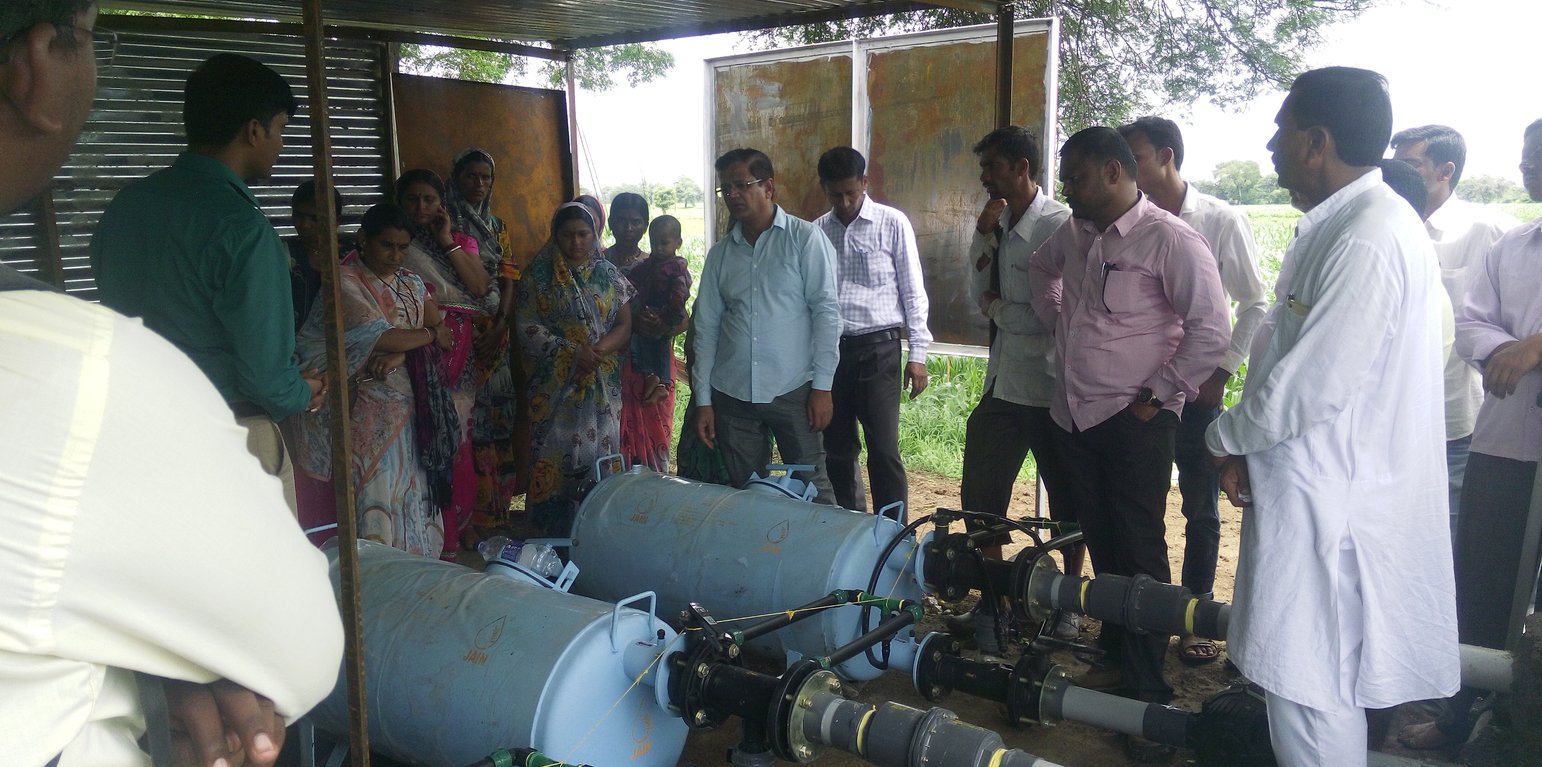



The group micro-irrigation (GMI) approach encourages farmers to share water more sustainably by facilitating cooperative management of irrigation resources in semi-arid regions. The aim is to improve water security and agricultural productivity by promoting climate-resilient agricultural (CRA) practices and addressing the behavioural factors that influence water resource sharing. By treating water as a shared community resource rather than private property, GMI promotes equitable distribution and sustainable use of limited water resources among farmers by organizing farmer groups and utilizing shared water management infrastructure.
The GMI approach is divided into four major components: (1) supply-side groundwater management to recharge and conserve water sources, (2) demand-side management via efficient micro-irrigation systems, (3) promotion of CRA practices to improve soil health, and (4) integration of applied research to develop tools that allow farmers to assess and improve their agricultural practices. These components aim to optimize water use, reduce crop production costs, and encourage farmer collaboration for shared resources and access to advanced agricultural technologies.
The primary objectives of the GMI approach are to improve water productivity, enhance crop yield, and reduce dependency on groundwater for irrigation, especially in regions facing water scarcity. Through group collaboration, the approach also aims to reduce individual investment costs for farmers, facilitate access to subsidies, and increase resilience to climate fluctuations. Additionally, by integrating CRA practices, GMI supports sustainable agricultural practices that contribute to long-term soil health and ecosystem stability.
The GMI approach involves several methods, including:
•Groundwater Management: rainwater harvesting and construction of soil and water conservation structures to replenish groundwater levels.
•Micro-Irrigation Systems: installation of shared drip and sprinkler irrigation systems that optimize water use and are accessible to all group members.
•CRA Practices: seed treatment, crop spacing, intercropping & trap cropping, applying farmyard manure (FYM), vermicompost, and organic waste compost, and making use of organic inputs, Bio-pest management practices including the use of pheromone traps, light traps, and bio-pesticides.
•Applied Research: use of tools like crop water budgeting, groundwater testing, and field book record-keeping, enabling farmers to make data-driven decisions.
The implementation of GMI involves four stages:
•Planning and Assessment: identifying suitable villages, farmer groups, and available water resources. Farmers with similar irrigation needs are grouped based on geographic proximity and water source access.
•Infrastructure Development: establishing common irrigation systems and water conservation structures, including dug wells, check dams, and pipelines.
•Training and Capacity Building: educating farmers on CRA practices, irrigation management, and using applied research tools for decision-making.
•Monitoring and Evaluation: regular assessment of crop and water productivity, adjustment of practices based on field data, and continuous training to ensure sustainability.
The GMI approach involves a range of stakeholders:
•Farmers: key participants who manage day-to-day operations, share resources, and implement CRA practices.
•Watershed Organisation Trust (WOTR): the primary implementing organization, providing technical support, training, and ongoing assessment.
•Local Government: supports funding for infrastructure, provides access to subsidies, and helps promote CRA practices.
•Agricultural Experts and Researchers: developing tools for applied research and supporting data analysis to improve productivity and water efficiency.
Farmers value the GMI approach for a variety of reasons, including lower individual investment, access to reliable water resources, and increased crop productivity. The cooperative aspect has strengthened community bonds and ensured equal access to resources. However, some farmers were initially hesitant to share water resources and bear the upfront costs of micro-irrigation systems. These concerns faded as the benefits of increased productivity and resource efficiency became clear.
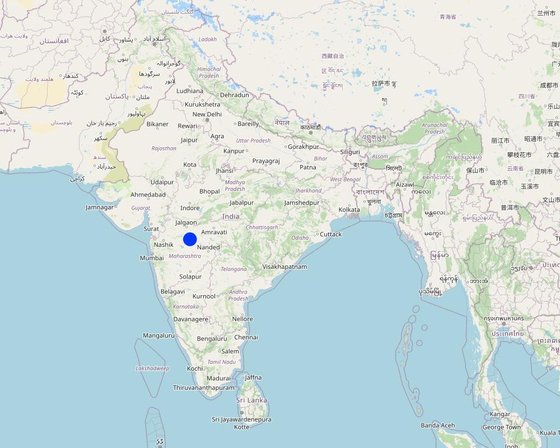
Location: Tigalkheda, Bhokardan Block, state: Maharashtra, India
Initiation date: 2017
Year of termination: n.a.
Type of Approach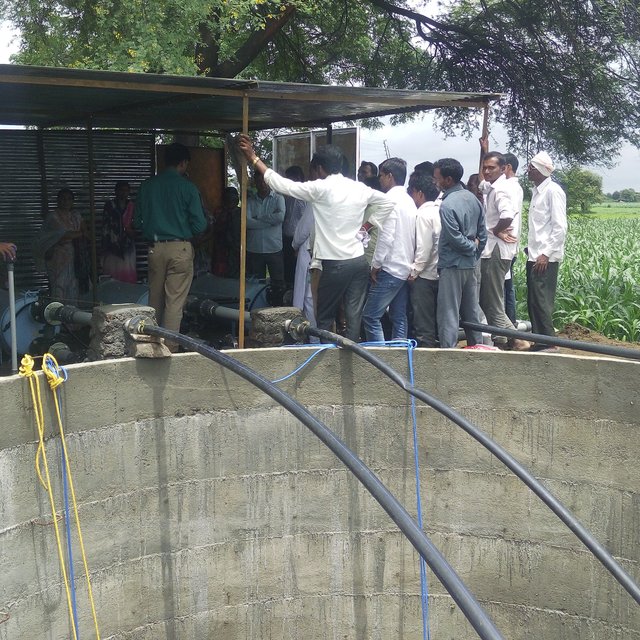
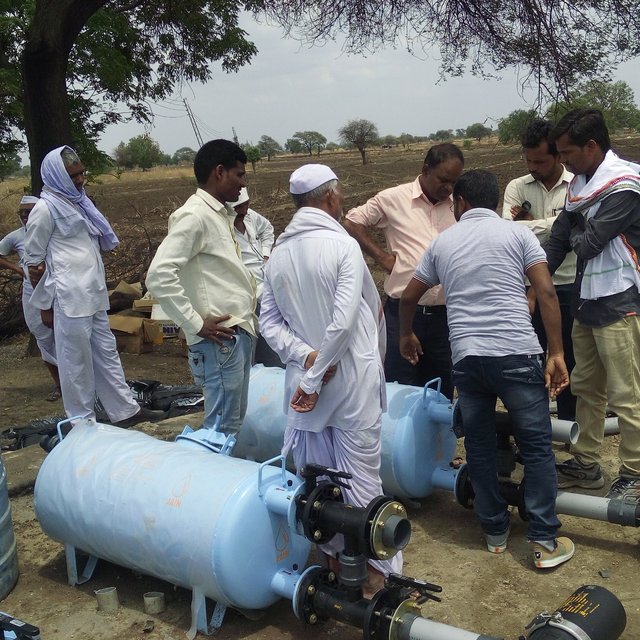
| What stakeholders / implementing bodies were involved in the Approach? | Specify stakeholders | Describe roles of stakeholders |
| local land users/ local communities | The primary stakeholders of the GMI model. They contribute to decision-making and implementation processes related to the irrigation system | |
| SLM specialists/ agricultural advisers | Offer guidance on sustainable land management (SLM) practices and assist farmers in adopting climate-resilient agricultural techniques, ensuring effective use of the micro-irrigation system. | |
| researchers | Researchers conduct studies to evaluate the effectiveness of the GMI model, focusing on behavioral aspects and mental models of farmers regarding water sharing. Their findings contribute to improving practices and informing policy decisions related to water management. | |
| NGO | Watershed Organisation Trust, (WOTR) Pune | WOTR is the implementing NGO that provides technical support, training, and capacity-building initiatives for farmers. WOTR facilitate community engagement and help establish the GMI model as a sustainable water-sharing approach. WOTR also carried out impact analysis and research components of GMI approach |
| private sector | Providing materials, micro-irrigation system | |
| national government (planners, decision-makers) | Promoted policies that support sustainable irrigation practices, such as the Pradhan Mantri Krishi Sinchai Yojana (PMKSY), which encourages micro-irrigation technologies across India. Provide subsidies for micro-irrigations | |
| international organization | GIZ | Funding of the project |
Linking of GMI components with the stakeholders
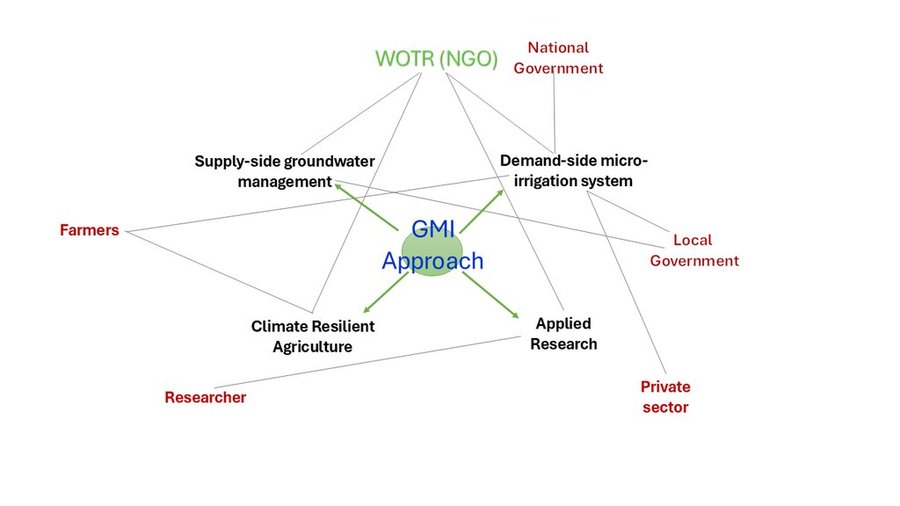
Decisions were taken by
Decisions were made based on
Water management practices, micro-irrigation systems installation, maintenance of drip irrigation, fertigation technologies, sustainable agricultural practices, climate-resilient farming techniques, cooperative management, collective decision-making and resource sharing among farmers.
Research was conducted by Miss. Upasana Koli, Dr. Arun Bhagat, and Dr. Marcella D’Souza from the Watershed Organisation Trust (WOTR). The focus of the research included understanding the mental models that promote water sharing for agriculture through the GMI approach. It examined behavioural aspects related to water resource management, cooperative practices among farmers, and the socio-economic impacts of adopting sustainable irrigation technologies. The findings aim to inform policymakers and practitioners about effective water-sharing policies and sustainable agricultural interventions.
Arun Bhagat: Contributed to the conceptualization, methodology design, investigation, data curation, formal analysis, original draft writing, and reviewing and editing of the manuscript.
Upasana Koli: Contributed to the conceptualization, methodology design, investigation, and data curation for the study.
Marcella D'Souza: Provided supervision and contributed to conceptualizing the research project.
labor costs related to the installation of irrigation systems.
Drip irrigation system
National government subsidies
National government subsidies
Dug-well development
Labour by land users was
Supporting Policies: Government policies such as the Pradhan Mantri Krishi Sinchai Yojana (PMKSY) provide financial assistance for micro-irrigation technologies
GMI developed a sense of ownership among farmers, leading to increased involvement in decision-making processes related to water management
Training sessions and workshops provided farmers with the knowledge needed to make informed decisions about irrigation practices
Farmers received hands-on training and technical support, enabling them to effectively implement micro-irrigation systems.
The cooperative model promoted collaboration among farmers, leading to more efficient resource use
Subsidies and credit options facilitated financial access for farmers adopting new technologies
Continuous training enhanced farmers' skills in sustainable agricultural practices
NGOs and local government bodies benefited from increased understanding of sustainable practices through their engagement in the project
The GMI model strengthened local farmer groups and enhanced collaboration with NGOs.
The shared water management approach reduced competition for resources among farmers.
The project specifically targeted small and marginal farmers, providing them with resources and support
Women participated in training sessions, enhancing their roles in agricultural decision-making.
Training and awareness campaigns have sparked interest among younger generations in sustainable farming practices.
The project addressed rights issues by promoting Community driver visual indicator (CDVI) tool
Enhanced irrigation practices have resulted in better crop yields, contributing to food security
By connecting the farmers with the local Farmers Produce Organisation (FPO) and market
Efficient water management has improved overall access to water resources for agricultural and domestic use.
Adoption of efficient irrigation systems has encouraged sustainable energy practices among farmers
By efficient water management practices and promoting climate resilient agricultural practices
Increased agricultural productivity has created additional income sources for farmers.
Farmers in Tigalkheda have developed a strong sense of ownership over the GMI approach. They have gained valuable knowledge and skills through training sessions provided by WOTR, enabling them to manage irrigation systems effectively. The cooperative structure established among local farmers facilitates resource sharing and collective decision-making, ensuring that they can maintain the technologies implemented. Additionally, the financial support received through subsidies has alleviated initial investment burdens, allowing farmers to sustain operations independently over time. This sustainability is further supported by the ongoing commitment of farmers to engage in sustainable agricultural practices, as they recognize the long-term benefits of improved water management and crop productivity for their livelihoods and the environment.